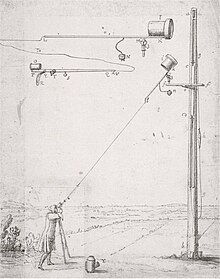
Back Telescopi aeri Catalan Luftteleskop German Aerteleskopo Esperanto Telescopio aéreo Spanish 空気望遠鏡 Japanese Teleskop powietrzny Polish Telescópio aéreo Portuguese Luftteleskop Swedish Hava teleskobu Turkish Безкорпусний телескоп Ukrainian

An aerial telescope is a type of very long focal length refracting telescope, built in the second half of the 17th century, that did not use a tube.[1] Instead, the objective was mounted on a pole, tree, tower, building or other structure on a swivel ball-joint. The observer stood on the ground and held the eyepiece, which was connected to the objective by a string or connecting rod. By holding the string tight and maneuvering the eyepiece, the observer could aim the telescope at objects in the sky. The idea for this type of telescope may have originated in the late 17th century with the Dutch mathematician, astronomer and physicist Christiaan Huygens and his brother Constantijn Huygens, Jr.,[2][3] though it is not clear if they actually invented it.[4]
- ^ "The Telescope". The Galileo Project. Retrieved 5 March 2012.
After about 1675, therefore, astronomers did away with the telescope tube. The objective was mounted on a building or pole by means of a ball-joint and aimed by means of a string...
- ^ King, Henry C. (2003), The history of the telescope, ISBN 978-0-486-43265-6
- ^ "The First Telescopes", Cosmic Journey: A History of Scientific Cosmology, Center for History of Physics, a Division of the American Institute of Physics, archived from the original on 2008-04-09, retrieved 2009-05-06
- ^ Bell, A. E. (1948), "Christian Huygens and the Development of Science in the Seventeenth Century", Nature, 162 (4117): 472–473, Bibcode:1948Natur.162..472A, doi:10.1038/162472a0
© MMXXIII Rich X Search. We shall prevail. All rights reserved. Rich X Search